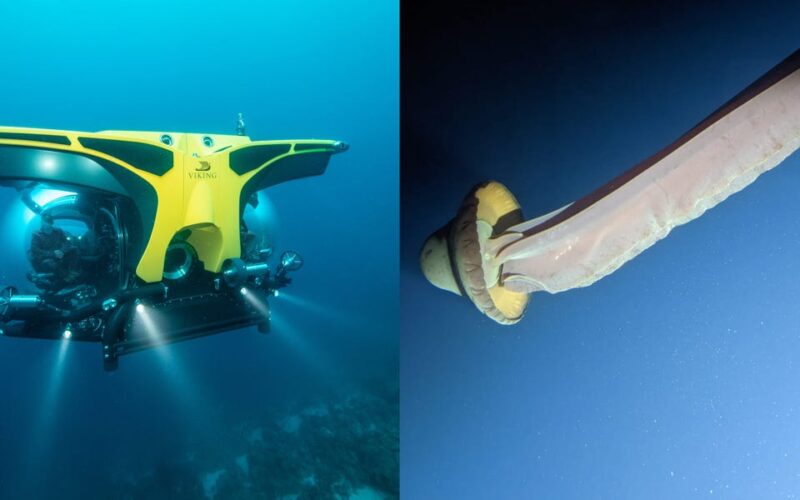Not so long ago, giant phantom jellyfish were an extremely rare sight, with fewer than 130 known sightings. Then tourists aboard personal submersibles started spotting them near the Antarctic Peninsula.
The submersible rides were part of a Viking Expedition trip. Viking Octantis, a luxury cruise vessel, takes thousands of passengers each year through the icy waters of the Southern Ocean to glimpse penguins, seals, and other wildlife.
All the majestic scenery and cruise ship amenities come with a healthy dose of science and the opportunity to contribute to cutting-edge Antarctic research. Trips start at $13,000 for a 13-day cruise.
Searching the deep seas for phantom jellyfish
Antony Gilbert/Viking Expedition
While scientists started using personal submersibles with increasing frequency in the 1990s and 2000s, Antarctic waters are generally still difficult and expensive to get to. Hopping in one right from Viking’s cruise ship makes things a little easier.
And it’s novel enough that every trip might lead to something unexpected. “The exciting thing is we can go into the water and say there’s a very real chance we might find something that is genuinely new,” Damon Stanwell-Smith, Viking’s head of science and sustainability told Business Insider.
Viking’s Octantis has two, six-passenger submersibles, which take guests down to depths of nearly 1,000 feet.
It was during three such trips in early 2022 that Viking tourists snapped pictures and took video of the giant phantom jellyfish. A year later, other guests had spotted a handful more, National Geographic reported.
First described in 1910, the jellyfish has an umbrella-like body with four ribbony arms, which help trap prey and can grow to over 33 feet each.
Gavin Newman/Viking Expedition
Finding the jellyfish has proven difficult in the past, and many mysteries remain about its habits. While they’re typically observed in deep water, all the Viking sightings were at less than 1,000 feet deep.
Based on the guests’ jellyfish encounters, the ship’s researchers published a scientific paper in 2023 in the peer-reviewed journal Polar Research discussing how submersibles can help lead to breakthroughs in Antarctica’s under-studied waters.
An expedition ship built for luxury and discovery
Alastair Miller/Viking Expedition
In addition to hangers built for subs, the Octantis and its sister ship, Polaris, were designed for many other types of science. There are 380-square-foot laboratories with equipment sophisticated enough for environmental DNA testing.
Stanwell-Smit said this capability is cutting-edge for any research vessel, not a cruise ship. “This is incredibly novel,” he said. It lets researchers genetically sequence biological samples right away instead of waiting months for another laboratory to do the work.
The cruise line’s commitment to science attracts a certain kind of tourist, which Stanwell-Smith refers to as the “retired professor demographic.”
The expedition ships cater to these educated, curious guests by letting them participate in research alongside the nine scientists on every voyage, whether to Antarctica or through the US’s Great Lakes.
Guests can listen to expert lectures from the ships’ resident wildlife naturalists or provide citizen scientist data about the birds they spot. Or they can get involved in what Stanwell-Smith calls “real science” by assisting on-board geochemists or oceanographers with research.
They can take a sample of phytoplankton, watch a weather balloon launch, or prepare a “bait popsicle” to help with a species-monitoring project.
Viking Expedition
Prepping the smelly bait is one of the expedition ships’ most popular activities, Stanwell-Smith said. “There’s a subset of our guests who want to roll up their sleeves, put a lab coat on, and just get really messy,” he said.
For those who weren’t experts before, Stanwell-Smith thinks the cruise will help them embrace the idea of loving what you know and protecting what you love.
“There is something very visceral about feeling you know something better by having actively done it rather than just watch somebody else or seen it on the screen,” he said.
Plus, they might witness something completely new that gets written up in a scientific journal.
Source link
lol

